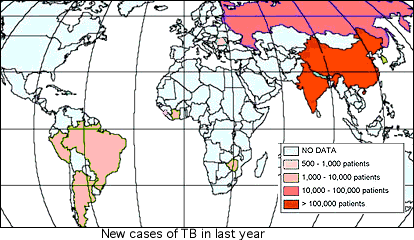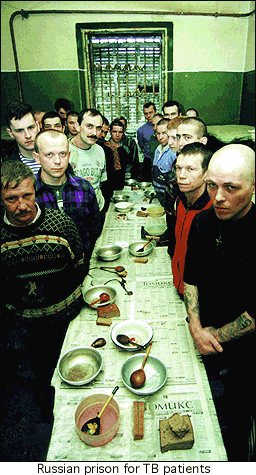
Incurable Form of TB is Global Threat
Monitor Wire Services
 |
Monitor Wire Services |
|
 Deadly
strains of drug resistant
tuberculosis dubbed "Ebola with wings" are spreading rapidly and threaten to spiral out of
control, according to a report released Thursday by Harvard and private groups.
Deadly
strains of drug resistant
tuberculosis dubbed "Ebola with wings" are spreading rapidly and threaten to spiral out of
control, according to a report released Thursday by Harvard and private groups.
The World Health Organization first sounded the TB alarm six years ago -- labeling the airborne bacteria a "global emergency." But with the increasing prevalence of drug resistant strains of the disease, the epidemic has taken a chilling new direction. In Russia, Estonia and other hotspots around the world cases of multidrug-resistant tuberculosis (MDR-TB) are reaching unprecedented levels. While TB and MDR-TB have traditionally been viewed as a scourge of the poor, the report traces the spread of MDR-TB to Western Europe and North America. The study documents drug-resistant TB in more than 100 countries. "The rapid rise of multidrug-resistant tuberculosis is a public-health catastrophe of the first order," says the report's lead author Dr. Paul Farmer, an associate professor of social medicine at Harvard Medical School. "MDR-TB is a man-made problem. When patients stop taking or don't take enough of the right medications, they develop resistance to the drugs, and then spread new drug-resistant strains of the bacteria." The report says that the impact of the Russian TB resurgence has already been felt well beyond the borders of the Russian Federation. Transnational cases -- TB acquired in one country, but diagnosed in another -- will likely become increasingly common, even if aggressive measures are taken at once. But although this outbreak has occurred in a technologically advanced industrial society, it remains unchecked. The study cites a 1999 report to the U.S. and Russian governments, where the Public Health Research Institute offered a troubling forecast:
"The tuberculosis epidemic in Russia, particularly in Russian prisons, has reached alarming proportions. The prison system acts as an epidemiological pump, releasing into society tens of thousands of active TB cases and hundreds of thousands of infected individuals every year. The high rate of multi-drug resistant tuberculosis among them is especially threatening." Immediate action and a massive infusion of new resources are urgently needed to bring this problem under control. While the report outlines an effective approach to the exploding epidemic, it also points out that without at least $1 billion in new funding for TB treatment in the immediate future, MDR-TB will spread to all corners of the earth. "If new money isn't made available immediately the epidemic may become virtually impossible to contain," said Dr. Farmer. "It is only a matter of time before MDR-TB becomes a serious threat in the developed world, and the cost of controlling it will be exponentially greater." |
|
 While
the treatment method recommended by
the World Health Organization (Directly Observed Therapy
Shortcourse -- or "DOTS") has been effective in controlling
traditional TB, the new drug resistant strains require greater
efforts to combat.
While
the treatment method recommended by
the World Health Organization (Directly Observed Therapy
Shortcourse -- or "DOTS") has been effective in controlling
traditional TB, the new drug resistant strains require greater
efforts to combat.
Principles of DOTS emphasize the treatment of active TB with standardized short-course chemotherapy; all doses received should be directly observed; most TB care can be delivered without the hospitalization; and control effortswith standardized reporting and evaluation. The report recommends the immediate implementation of the WHO's standard DOTS program so that all TB patients receive appropriate treatment. In areas where MDR-TB is already a problem, the report calls for the rapid implementation of the "DOTS-Plus" approach, under close WHO supervision. DOTS and DOTS-plus involve intensive monitoring and record keeping of patients' treatment -- confirming that it is carried out correctly and completely. Another area with growing MDR-TB crisis is Peru, which has only in the past decade been successful in controlling TB. There are now 65,000 newTB cases every year, ranking Peru 20th in the world. In national study, MDR-TB was found in 15.7 percent of the patients previously treated. Since 1990, when a DOTS-based program was instituted, the efficacy of TB control has improved markedly. But poor program performance in the past -- in particular, low cure rates -- has left behind a tangible legacy: endemic antituberculous drug resistance. The case of Peru, which now has one of the best TB control programs in the world, illustrates how the epidemiology of drug-susceptible and drug-resistant TB cannot be viewed separately; in such settings, careful tailoring of TB treatment program strategies will be critical. The report also highlights the need for new drugs. "As with all antibiotics, anti-tuberculosis drugs are at risk of becoming obsolete if they are not managed with great care," says report co-author Dr. Jim Kim. "Direct observation of each dose, will help prevent the emergence of more drug-resistance. But new drugs must be developed."
Albion Monitor
October 31, 1999 (http://www.monitor.net/monitor) All Rights Reserved. Contact rights@monitor.net for permission to use in any format. |